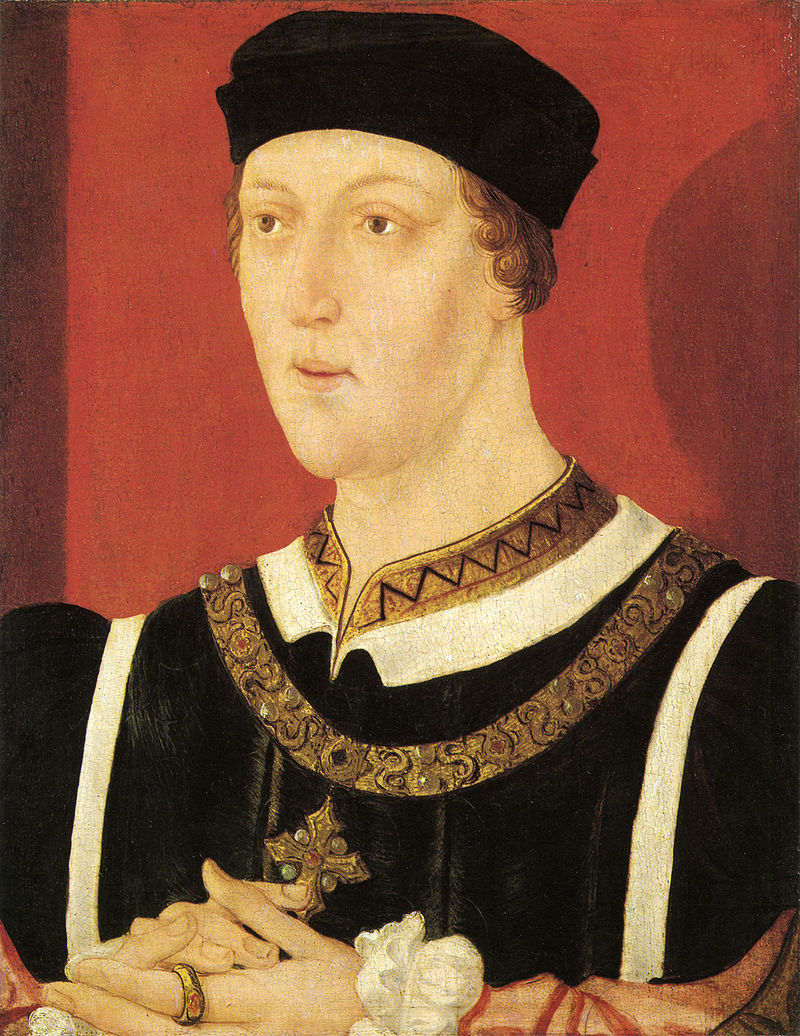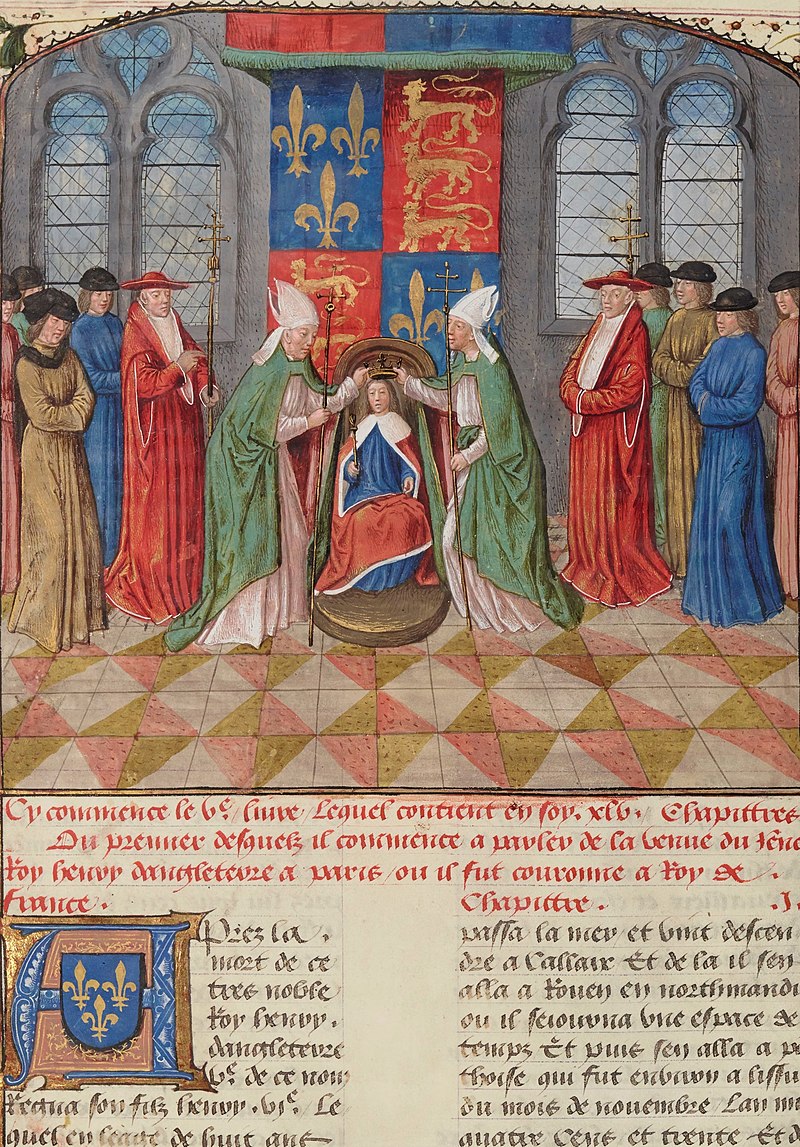by Susan Flantzer © Unofficial Royalty 2015

King Henry VI of England; Credit – Wikipedia
King Henry VI from the House of Lancaster had a tough act to follow. His father was King Henry V, a warrior king, the victor against the French at the Battle of Agincourt, determined to conquer France once and for all, succumbed to dysentery, a disease that killed more soldiers than battle, on August 31, 1422, at the age of 35, leaving a nine-month-old son to inherit his throne. Two years before his death, Henry V had married Catherine of Valois, the daughter of King Charles VI and Isabeau of Bavaria. On October 21, 1422, Henry VI became titular King of France upon his grandfather Charles VI’s death in accordance with the Treaty of Troyes.
Henry VI, born on December 6, 1421, at Windsor Castle, is the youngest-ever English monarch. He is also on the top ten list of longest-reigning British monarchs, coming in at number seven. He reigned for two periods, from August 31, 1422 – March 4, 1461, and then from October 31, 1470 – April 11, 1471, for a total period of 38 years, 347 days. The baby king, seated in his mother’s lap, presided over Parliament on September 28, 1423, when the nobles swore loyalty to him. One of Henry V’s surviving brothers, John, Duke of Bedford, was appointed Regent and put in charge of the ongoing war in France. During Bedford’s absence, the government of England was headed by Henry V’s other surviving brother, Humphrey, Duke of Gloucester, who was appointed Protector and Defender of the Realm.

Henry VI’s accession; Credit – Wikipedia
With Henry’s mother Catherine being a young widow with apparently no chance of remarriage, it should not seem unusual that an amorous relationship would be likely. Owen ap Maredudd ap Tudor, a Welsh soldier, served in Catherine’s household and their relationship began when Catherine was living at Windsor Castle. There is much debate as to whether Catherine and Owen married. No documentation of marriage exists and even if they did marry, their marriage would not have been legal due to the act regarding the remarriage of a queen dowager. From the relationship between Owen Tudor and Catherine of Valois descended King Henry VII of England and the Tudor Dynasty. Through their great-granddaughter Margaret Tudor descended the British royal family and many other European royal families.
Henry VI had at least six half-siblings from the relationship between his mother Catherine and Owen Tudor:
- Thomas Tudor (1429 – 1501) He became a monk at Westminster Abbey and was known as Edward Bridgewater.
- Edmund Tudor, 1st Earl of Richmond (1430 – 1456) He married Lady Margaret Beaufort, and they were the parents of Henry Tudor, the future King Henry VII, Edmund died of the plague shortly before his son’s birth.
- Jasper Tudor, 1st Earl of Pembroke and 1st Duke of Bedford (1431 – 1495) He married Catherine Woodville, daughter of Richard Woodville, 1st Earl Rivers and Jacquetta of Luxembourg. He had no legitimate children but did have two illegitimate children. One was Joan Tudor, an ancestor of Oliver Cromwell.
- Owen Tudor (1432–1510) He became a monk at Westminster Abbey.
- Tacinda Tudor (b. 1433) She married Reginald Grey, Baron Grey of Wilton and had issue.
- (Daughter) Tudor (b. c. 1435) She became a nun.
- Margaret (Catherine) Tudor (born January 1437), died shortly after birth.
Henry VI was crowned at Westminster Abbey in London, England on November 6, 1429. Two years later, on December 16, 1431, he was crowned King of France at Notre Dame Cathedral in Paris, France. Before Henry came of age, English rule in France had begun a steady decline with Joan of Arc‘s campaign supporting the Dauphin of France, later King Charles VII of France. By 1453, only Calais remained of Henry V’s French conquests.

Henry being crowned King of France in Notre Dame Cathedral in Paris; Credit – Wikipedia
Henry VI, more interested in religion and learning than military matters, was not a successful king. He was shy, peaceful, and pious, hated bloodshed and deceit, and was not a warrior like his father. Instead of wearing the fashions of the day, Henry dressed in the clothing of a farmer or merchant. He lacked any administrative skills which left him open to the machinations of his advisers. Henry was very concerned with the two educational institutions he had founded, Eton College and King’s College, Cambridge.

Statue of the founder Henry VI in the central yard of Eton College; Credit – Wikipedia
When it was time for him to marry, his advisers persuaded Henry VI that the way to achieve peace with France was to marry Margaret of Anjou, the niece of King Charles VII of France. The couple was married at Titchfield Abbey in England on April 23, 1445. Margaret was to prove as strong as Henry was weak.

The marriage of Henry VI and Margaret of Anjou; Credit – Wikipedia
Henry and Margaret had one child, born eight years after their marriage:
- Edward of Westminster, Prince of Wales (1453 – 1471), married Anne Neville (who later married King Richard III), no children, killed at the Battle of Tewkesbury
Shortly before his son was born, Henry VI had a mental breakdown. He was unable to recognize or respond to people for over a year. These attacks may have been hereditary. Henry’s maternal grandfather King Charles VI suffered similar attacks, even thinking he was made of glass. Sometimes Henry also had hallucinations which makes some modern medical experts think he may have had a form of schizophrenia. Porphyria, which may have afflicted King George III, has also been suggested as a cause. During Henry’s incapacity, Richard Plantagenet, 3rd Duke of York and the next in line to the throne after Henry’s son, governed as Lord Protector.
Even before the birth of Henry’s son, factions were forming and the seeds of the Wars of the Roses were being planted. Henry’s wife Margaret aligned herself with Edmund Beaufort, 2nd Duke of Somerset. Margaret believed her husband was threatened with being deposed by Richard Plantagenet, 3rd Duke of York who thought he had a better claim to the throne and would be a better king than Henry. After Henry’s recovery in 1455, the Duke of York was dismissed, and Margaret and the Duke of Somerset became all-powerful. Eventually, things came to a head between the Lancastrians and the Yorkists, and war broke out.
At the First Battle of St. Albans on May 22, 1455, the Duke of Somerset was killed. Afterward, there was a peace but hostilities started again four years later. On July 10, 1460, Henry was captured at the Battle of Northampton and was forced to recognize the Duke of York as his heir instead of his own son. Margaret rallied the Lancastrian forces and was victorious at the Battle of Wakefield on December 29, 1460. The Duke of York and his second son Edmund, Earl of Rutland were both killed in the battle.
The leader of the Yorkists was now the late Duke of York’s eldest son Edward, Earl of March (the future King Edward IV). During the Second Battle of St. Albans on February 17, 1461, Henry’s freedom was secured and it is alleged that he laughed and sang insanely throughout the battle. The Yorkists regained the upper hand at the Battle of Towton on March 29, 1461. Edward, Earl of March defeated the Lancastrian forces in a snowstorm. Henry fled to Scotland, and England had a new king, Edward IV from the House of York.
Henry VI returned from Scotland in 1464 and participated in an ineffective uprising. In 1465, Henry was captured and taken to the Tower of London. Margaret, exiled in France, wanted to restore the throne to her husband. Coincidentally, King Edward IV had a falling out with his major supporters, his brother George, Duke of Clarence and Richard Neville, 16th Earl of Warwick, known as the Kingmaker. Margaret, Clarence, and Warwick formed an alliance at the urging of King Louis XI of France. Edward IV was forced into exile, and Henry VI was restored to the throne on October 30, 1470. However, once again, Edward IV got the upper hand. Edward IV returned to England in early 1471 and killed Warwick at the Battle of Barnet. The final decisive Yorkist victory was at the Battle of Tewkesbury on May 4, 1471, where Henry VI’s son Edward was killed. Henry VI was returned to the Tower of London and died on May 21, 1471, probably murdered on orders from Edward IV.
The site in the Tower of London (the Wakefield Tower) where Henry VI died; Credit – Wikipedia
King Henry VI was first buried at Chertsey Abbey but was moved in 1484 by King Richard III, brother of King Edward IV, to St. George’s Chapel at Windsor Castle. Ironically, the burial sites of King Henry VI and his rival King Edward IV lie opposite each other in eternal peace.
Henry VI had half-siblings from his mother’s second marriage to Owen Tudor, one of whom was Edmund Tudor, 1st Earl of Richmond who married Lady Margaret Beaufort. Their son Henry Tudor, eventually was the senior male Lancastrian claimant remaining after the Wars of the Roses. In 1485, Henry Tudor won the English throne when his forces defeated the forces of King Richard III, King Edward IV’s brother, at the Battle of Bosworth Field, becoming King Henry VII by the right of conquest. Henry VII married Elizabeth of York, the eldest daughter of the Yorkist King Edward IV, and started the House of Tudor.

Tomb of Henry VI; Credit – findagrave.com
This article is the intellectual property of Unofficial Royalty and is NOT TO BE COPIED, EDITED, OR POSTED IN ANY FORM ON ANOTHER WEBSITE under any circumstances. It is permissible to use a link that directs to Unofficial Royalty.
England: House of Lancaster Resources at Unofficial Royalty
